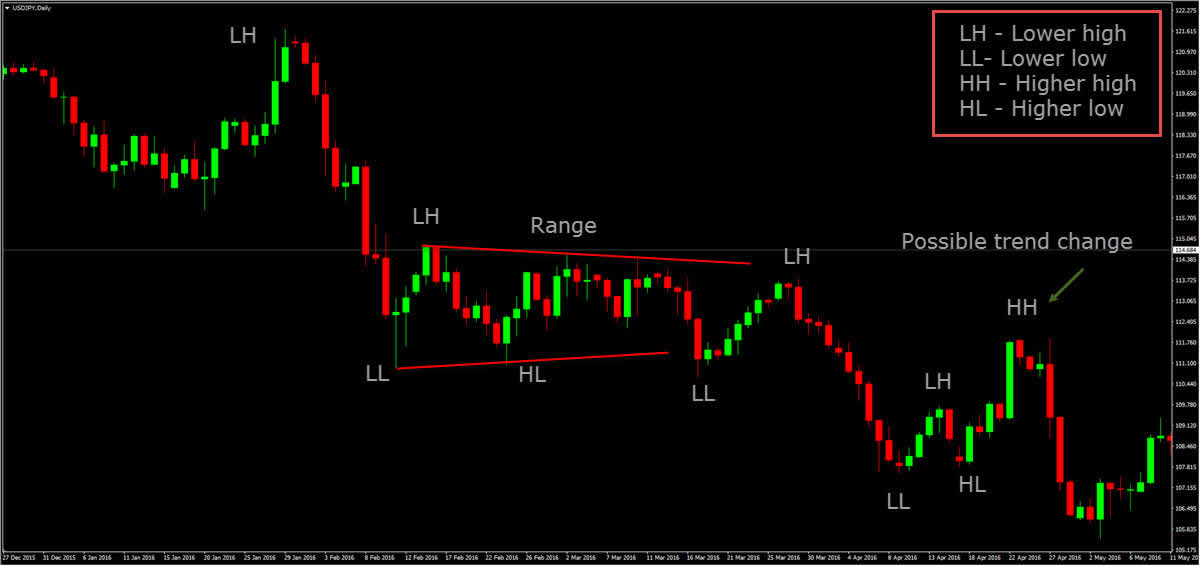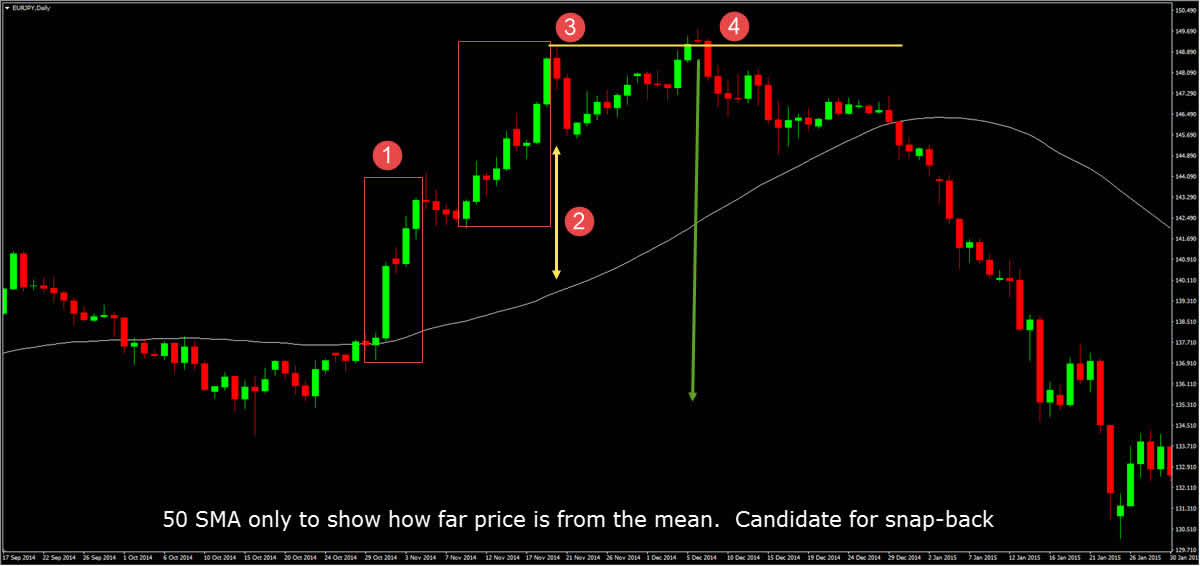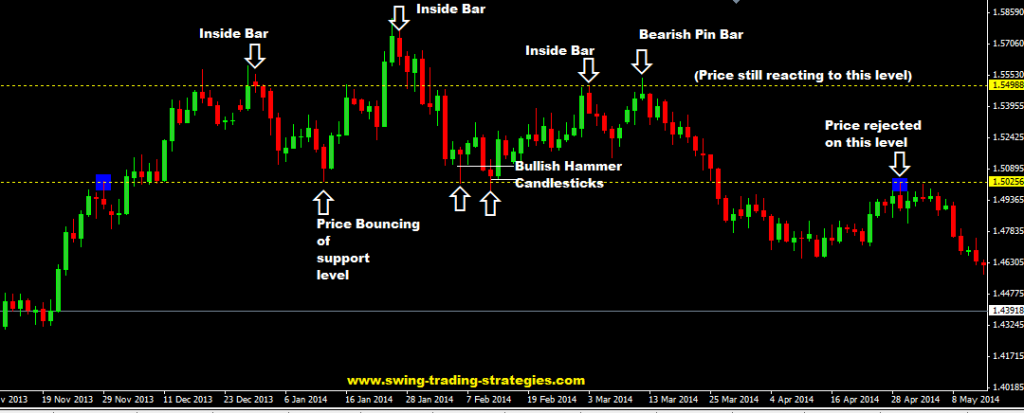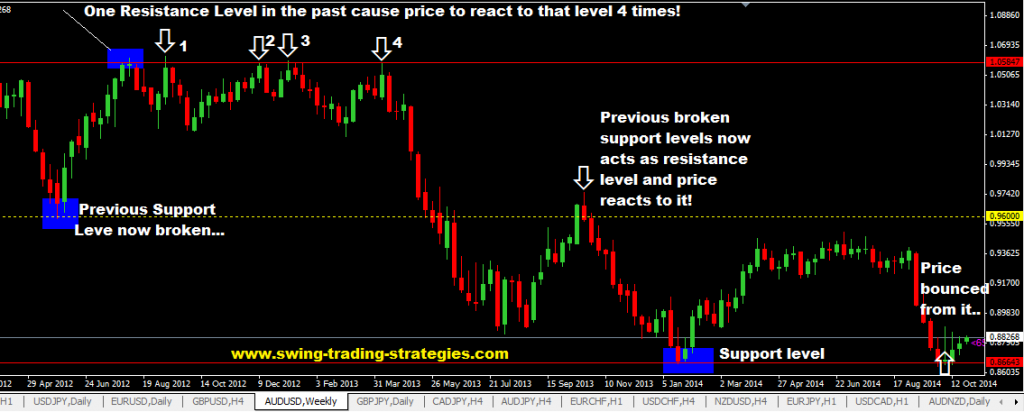Price action trading, also called trading naked is about being able to read the price movement on a chart and base your decision off of that movement and the price structure it leaves behind.
The reason the alternate term of trading naked is used is because the price action trader relies on the chart without the use of trading indicators.
Why no trading indicators?
Since all trading indicators use information from the movements of price, they require price to move first therefore they lag price. Price action traders have developed the skill of understanding that the movement of price can point to the probability of one thing happening over another.
Those who believe that all price movement is random would NOT would not be suited to a price action based trading strategy. While much of what we see on the chart may be random, price action at various points in the chart, inflection points, can point to an imbalance of supply/demand which may be exploited.
Definition: Price action trading means you are making all your trading decisions based on what you see on your Forex trading charts just based on pure price action…which means just the price movement shown through candlesticks or price bars. This means there is very minimal use of lagging Forex indicators and the only exception is that you may use one or two moving averages basically to help you identify dynamic support and resistance levels and trend.
Price Action Traders And Crowd Psychology
Price action traders believe that the trading chart is combination of the many beliefs and emotions that other traders have in regards to a certain trading instrument. They believe that all price movement occurs due to the psychology of the crowd, and that the dominate crowd belief will push the market.
When reading a price chart, price action traders will look for various trading patterns that are formed by the movement of price. These price patterns will then lead them to make decisions based on the context the pattern is found in.
As shown in this chart, price action traders will often highlight support and resistance zones on the chart where the market has responded to in the past. They will watch for candlestick patterns such as inside bars, pin bars, and more complicated price patterns such as head and shoulders and double/triple bottoms.
While this chart may make it appear the price action trading is easy to do, it is not. It is a specialized form of technical analysis that requires a solid understanding of market mechanics as well as the meaning or implied meaning being the relationship between individual candlesticks or bars.
Since it is a form of discretionary trading, price action trading requires traders to have a firm grip on trading psychology especially fear and greed. It is far too common for traders to impose their will or bias on a chart and since our brains are “pattern recognition machines”, it is easy to see something that simply is not there.
Price action trading is fairly robust which means it can apply to most liquid markets as well as time frames which makes it ideal for day trading all the way to position traders.
Price Action Trend Determination
One of the basic ways of using the movement of price is to determine the trend of the market you are looking at. We first want to understand the when price is moving upwards we expect to see:
- Price making higher swing highs
- Price making higher swing lows
Conversely, the opposite price movement would indicate price is moving downwards we can consider than a downtrend:
- Price making lower swing highs
- Price making lower swing lows.
But price does not just trend up and down. It can also range and that is when we start seeing a mixture of the two states combined as you can see with the 2 red lines.

Determining trend through price action
We get a possible trend change when price moves up the latest lower high on the right side of the chart and puts in a higher high. We need to see price hold the higher low to confirm a trend change however in this case, price broke back to the downside reaffirming our trend direction down.
Support And Resistance Trading
One of the uses a Forex trader may have for price action trading is in relation to support and resistance levels. In simple terms, support is defined as the price level where price has bounced up from after it had been moving downwards. Now, if it bounces more than once on this price level every time it comes to this level, it can make this support level more significant – to a point. This is when you start seeing the double or triple bottom trading pattern form.
A resistance level is a price level where price after going up for some time, falls back from as noted with the top red line. And similar to the support level, if price tries to go up back to this level and break it but keeps getting knocked back down by more than once, this makes this resistance level a significant level – to a point.
While many traders think multiple hits makes a support or resistance level stronger, the opposite is often true. Many traders place their stop just beyond these levels and often times traders will be hit by a stop run that takes them from their trades and then price movement continues in the direction the trader wanted. This is the general area that you will see the formation of a pin bar which is a price action pattern you can trade depending on the location it is found.
My Favorite Pure Price Action Trading Strategy
While I enjoy using many strategies that rely on simply watching the movements of price, one of my top picks uses two patterns that come from Richard Wyckoff that helps pinpoint trapped traders in the Forex market (or any other market to be exact). It’s a form of a pin bar pattern combined with support or resistance plus price movement that has pulled far away from the mean (think mean reversion when the elastic band is pulled too far).

Pure Price Action Trading Strategy
This pattern is my favorite for swing trading but is also fine for day traders who are looking for a quick pop lower or higher in the market but ensure you look for the following:
- Price movement indicates strong bull interest easily seen by the bullish candlestick patterns that are forming.
- The moving average is to illustrate the price has moved a good distance away from the mean and is possibly overbought at this point.
- Price puts in a high and drops back putting in a potential resistance zone. Price action afterwards shows momentum bear candles pointing to profit taking or shorts in play.
- Price moves over the resistance zone, puts in an upthrust and collapses back inside. This is a shorting opportunity.
Wrapping It Up….
I hope you can see the power of being a price action trader and the opportunity it gives you to be able to trade many markets including Forex. You don’t need to spend time tweaking lagging price indicators looking for the best settings (which do not exist) or using a combination of them.
Learning simple price action trading techniques such as the strategy I presented can go a long way in helping you find trading success.






 Posted in
Posted in